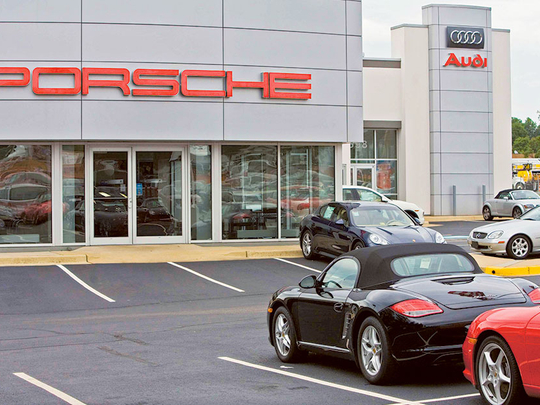
The strong dollar and threat of deflation may be wreaking havoc on European economies, but as an American consumer it has made me feel flush.
Last week the euro dropped below $1.18, the weakest level in nine years, and it has depreciated more than 5 per cent in just the last three months. The slide has been so steep that the Swiss central bank untethered the Swiss franc, which promptly soared against the euro. So I figured there’s no better time to go bargain hunting for European imports. (Or book a trip to Europe, but that’s another story.)
This week I went on a quest for two things I’d love to buy, if money were no object: a Porsche sports car, and a Brunello Cucinelli suit. (It’s just as well a Swiss watch wasn’t on my list.)
At a Porsche dealer, Manhattan Motorcars, a gleaming “rhodium silver” Porsche Boxster and its hardtop cousin, a dark blue metallic Cayman, both had sticker prices of about $64,000 (Dh235,000) — a bargain compared with six-figure Porsche models. A Porsche spokesman told me that the automaker actually raised the suggested retail price to $51,400 this month from $50,400 a year ago for the base model Boxster.
At the elegantly minimalist Madison Avenue outlet for the Italian designer Brunello Cucinelli, Corey Easley, a salesman, showed me several suits and jackets in my size (European 52) in the ethereal fabrics for which Cucinelli is famous.
And this being January, they were 40 per cent off. A soft grey “large check” suit was marked down to $2,670 from $4,450. But a Cucinelli spokeswoman told me this was a slight increase from last year, reflecting higher material and labour costs, and the markdown was seasonal, one of two annual sales. The price didn’t have anything to do with the strong dollar.
So much for bargains.
It turns out that retail pricing, especially for highly differentiated luxury brands with fat profit margins, is far more complicated than just looking up the latest exchange rates.
Antonio Rodriguez-Lopez, assistant professor of economics at the University of California, Irvine and author of the article ‘Prices and Exchange Rates: A Theory of Disconnect’, told me that my intuition that prices should be lower thanks to the weak euro makes sense, all else being equal.
Naturally, this being economics, all else isn’t equal.
“This isn’t happening with the goods you describe, and more generally it will only cause, on average, a 1 or 2 per cent decline in the US prices of imported goods after a 10 per cent dollar appreciation,” he said. Economists refer to this phenomenon as “incomplete exchange rate pass-through”.
Why that would be is the subject of much academic research, but, using wine as an example, as the euro declines, the “markups are also changing”, he said.
“The wine producer will increase its markup in the US, cancelling out the decline in marginal cost,” he said. “French firms will not fully pass through the benefits of a stronger dollar to US consumers, but will get a cut from it in the form of higher markups.”
Alison Kenney Paul, vice-chairwoman for the retail and distribution sector for the consulting and accounting firm Deloitte, agreed that many European producers of luxury goods were using the strong dollar to pad their margins.
“Demand is good enough that they’ll just take the exchange arbitrage and put it into higher margins,” Paul said. “You may never see a price difference, and prices could keep inching up. The folks who are buying these brands aren’t that price-sensitive. The luxury of having a great global brand is that you don’t have to rely on price incentives.”
Paul noted that there was also a lag between a change in exchange rates and consumer prices. “The supply chain for automobiles or even wine is quite extended,” she said. “There’s a lot in the pipeline already. It may take six months or more before you start seeing an effect.”
Bordeaux wine producers, for example, are expected to announce prices this spring for the 2014 vintage, most of which won’t appear on retail shelves for several years.
Harald Hendrikse, European auto analyst for Morgan Stanley in London, said that Porsche was something of a special case, even among luxury automakers. “Porsche has the highest margins in the world. It’s not a high-volume manufacturer,” he said. With demand growing and manufacturing already near capacity, “they don’t really have any incentive to cut prices”.
“They’re going to get a tremendous benefit on the margins,” he continued.
Among luxury automakers, Mercedes-Benz and BMW appear to be in a fierce battle for the crown of best-selling premium import, and they were offering big incentives in December — up to $5,000 per car in the case of Mercedes and $6,000 for BMW, according to Hendrikse of Morgan Stanley. Some of this may be seasonal, since the end of the year is typically a good time to buy a car. But he noted that the incentives were higher than in the past.
“The reality is that every carmaker around the globe is facing lower costs thanks to the dollar, except those producing in the US,” Hendrikse said. “So there is going to be more price competition.”
As Paul of Deloitte told me, some bargains are likely to materialise, but “if you want to find them, you’re going to have to look harder.”
After my trip to the Cucinelli boutique, I visited the sixth floor of Barneys, just across the street, where the store features its high-end imported brands. An Isaia sports jacket from Italy in a beautiful fabric that fit perfectly was 60 per cent off at $1,149, marked down from $2,895.
Tempting, but I didn’t buy it. At least not yet.












